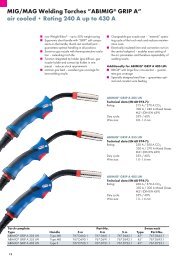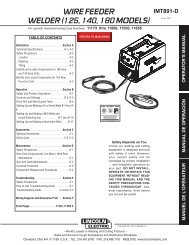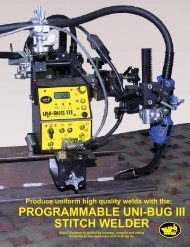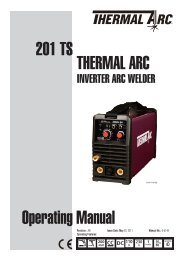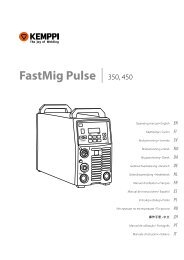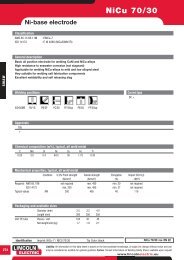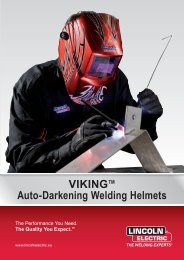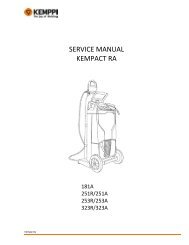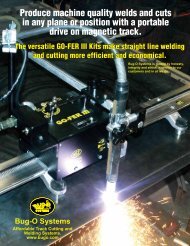mig welding - Rapid Welding and Industrial Supplies Ltd
mig welding - Rapid Welding and Industrial Supplies Ltd
mig welding - Rapid Welding and Industrial Supplies Ltd
You also want an ePaper? Increase the reach of your titles
YUMPU automatically turns print PDFs into web optimized ePapers that Google loves.
Additional Metal Surcharge(s) May ApplyTIPS<strong>Welding</strong> Copper <strong>and</strong> BrassCopperPure copper has characteristics of high thermal <strong>and</strong> electrical conductivity <strong>and</strong>, because the metal requiresabout six times more heat (melting point is 1,083ºC) for fusion <strong>welding</strong> than steel, particular care must be takenduring <strong>welding</strong> <strong>and</strong> brazing.Tough pitch copper, which includes most varieties of high conductivity copper, contains up to 0.5% oxygen(cuprous oxide) <strong>and</strong> is not suitable for fusion <strong>welding</strong> since it has a tendency to embrittlement <strong>and</strong> cracking,though it can be brazed.Deoxidised copper, where the oxygen has been removed during manufacture by the use of deoxidising agents,can be fusion welded.For MIG <strong>and</strong> TIG <strong>welding</strong>, It will be necessary to preheat workpiece if it is over 6mm thick. The usual shieldinggas is argon, but with thicker material an argon/helium mixture can beneficially increase the arc temperature.Consumables to be used are SIFMIG 985 <strong>and</strong> Sifsilcopper No 985, although Sifsilcopper No 7 can be used forTIG <strong>welding</strong> sheet up to 3mm thick.Gas <strong>welding</strong> of copper, such as whiskey stills, tanks etc, requires the parts to be preheated to 600ºC <strong>and</strong> slowlycooled on completion of the joint. Sifsilcopper No 7 together with Sifsilcopper flux will produce a joint withexcellent colour match.Copper is not generally joined using arc <strong>welding</strong> electrodes. But in circumstances where there is no other<strong>welding</strong> equipment other than a transformer, Hilco Bronsil proves ideal.BrassBrass is a generic term covering a wide range of copper alloys containing additions of zinc. All brasses, whichincludes Gilding Metal, can be silver soldered, MIG <strong>and</strong> TIG welded successfully. However, the addition of leadfor free cutting brass <strong>and</strong> in gunmetal (LG1 & LG2) causes porosity <strong>and</strong> fume problems with gas shielded arc<strong>welding</strong>. Phosphor Bronze, copper/tin alloys such as PB2, can be readily brazed or welded.Gas <strong>welding</strong> of brass is not recommended as the zinc will tend to vaporise causing fumes (zinc oxide) <strong>and</strong>porosity. However, PB2 phosphor bronze can be joined with oxy-acetylene <strong>and</strong> Sifphosphor Bronze No 8, assometimes used by sculptors.For MIG <strong>and</strong> TIG <strong>welding</strong> a shielding gas of argon or argon/carbon dioxide mixture is used. If it is felt necessaryto use preheat, this must be limited to less than 80ºC, otherwise the structure of the brass may become altered.The choice of filler wire or rod will depend on the composition of the alloy being joined. As a general comment,SIFMIG 8 or Sifphosphor Bronze No8 is recommended as first consideration. However, SIFMIG 328 <strong>and</strong> 968 orSifalbronze No 32 <strong>and</strong> Sifsilcopper No 968 may also be suitable. If colour match with brass is important,Sifphosphor Bronze No 82 is recommended.www.<strong>Rapid</strong><strong>Welding</strong>.com132



